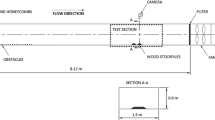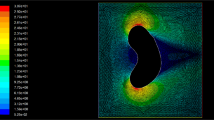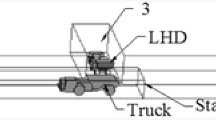Abstract
In recent years, the industrial demand for petcoke—a solid residue derived from the refinement of crude oil—has been growing due to its low cost. The use of petcoke is causing environmental concern associated with its high level of contaminants and air pollutant emissions, mainly particulate matter (PM). Given the impact of petcoke on the environment and human health, increased attention has been given to its production, storage, transportation, and application processes. The main goal of this work was to assess the effectiveness of placing a barrier to reduce PM emissions from petcoke in a harbor area. The Port of Aveiro, Portugal, was used as case study. Firstly, wind tunnel experiments were performed for different types of barrier to (i) assess the effect on PM emissions of different types of barriers, namely solid, porous, and raised porous barriers; (ii) determine the optimal size and location of the barrier to achieve maximum reduction of PM emissions; and (iii) estimate the impact of placing such barrier in the attenuation of petcoke emissions over the harbor area. Secondly, the numerical model VADIS (pollutant DISpersion in the atmosphere under VAriable wind conditions) was run to evaluate the effect of implementing the barrier on the local air quality. Results showed that the best solution would be the implementation of two solid barriers: a main barrier of 109 m length plus a second barrier of 30 m length. This measure produced the best results in terms of reduction of the dispersion of particulate matter from the petcoke stockpile and minimization of the PM concentrations in the harbor surrounding area.












Similar content being viewed by others
References
Amorim JH, Rodrigues V, Tavares R, Valente J, Borrego C (2013) CFD modelling of the aerodynamic effect of trees on urban air pollution dispersion. Sci Total Environ 461-462:541–551. https://doi.org/10.1016/j.scitotenv.2013.05.031
Avelar A, Brasileiro F, Marto A, Maricotto E, Fisch G, Faria A (2012) Wind tunnel simulation of the atmospheric boundary layer for studying the wind pattern at Centro de Lançamento de Alcântara. J Aerosp Technol Manag 4:463–473. https://doi.org/10.5028/jatm.2012.04044912
Baker LF, Ciborowski JJH, MacKinnon MD (2012) Petroleum coke and soft tailings sediment in constructed wetlands may contribute to the uptake of trace metals by algae and aquatic invertebrates. Sci Total Environ 414:177–186. https://doi.org/10.1016/j.scitotenv.2011.10.011
Balakrishnan K, Ganguli B, Ghosh S, Sambandam S, Roy S, Chatterjee A (2013) A spatially disaggregated time-series analysis of the short-term effects of particulate matter exposure on mortality in Chennai, India. Air Qual Atmos Health 6:111–121. https://doi.org/10.1016/j.atmosenv.2014.04.057
Borrego C, Tchepel O, Costa AM, Amorim JH, Miranda AI (2003) Emission and dispersion modelling of Lisbon air quality at local scale. Atmos Environ 37:5197–5205. https://doi.org/10.1016/j.atmosenv.2003.09.004
Borrego C, Costa AM, Amorim J, Santos P, Sardo J, Lopes M, Miranda AI (2007) Air quality impact due to scrap-metal handling on a seaport: a wind tunnel experiment. Atmos Environ 41:6396–6405. https://doi.org/10.1016/j.atmosenv.2007.01.022
Caruso JA, Zhang K, Schroeck NJ, McCoy B, McElmurry SP (2015) Petroleum coke in the urban environment: a review of potential health effects. Int J Environ Res Public Health 12:6218–6231. https://doi.org/10.3390/ijerph120606218
Contini D, Gambaro A, Donateo A, Cescon P, Cesari D, Merico E, Citron M (2015) Inter-annual trend of the primary contribution of ship emissions to PM2.5 concentrations in Venice (Italy): efficiency of emissions mitigation strategies. Atmos Environ 102:183–190. https://doi.org/10.1016/j.atmosenv.2014.11.065
CRS (Congressional Research Service) (2013) Petroleum coke: industry and environmental issues. Washington D.C., U.S.A.
Dourson ML, Chinkin LR, MacIntosh DL, Finn JA, Brown KW, Reid SB, Martinez JM (2016) A case study of potential human health impacts from petroleum coke transfer facilities. J Air Waste Manag Assoc 66:1061–1076. https://doi.org/10.1080/10962247.2016.1180328
EEA (European Environment Agency) (2013) Air quality in Europe — 2013 report. Copenhagen, Denmark
ESPO (European Sea ports Organisation) (2013) Top environmental priorities of European ports for 2013. An analysis taking port size and geography into consideration. Brussels, Belgium
Grahame T, Schlesinger R (2010) Cardiovascular health and particulate vehicular emissions: a critical evaluation of the evidence. Air Qual Atmos Health 3:3–27. https://doi.org/10.1007/s11869-009-0047-x
Guttikunda S, Goel R, Mohan D, Tiwari G, Gadepalli R (2015) Particulate and gaseous emissions in two coastal cities: Chennai and Vishakhapatnam, India. Air Qual Atmos Health 8:559–572. https://doi.org/10.1007/s11869-014-0303-6
Healy RM, O’Connor IP, Hellebust S, Allanic A, Sodeau JR, Wenger JC (2009) Characterisation of single particles from in-port ship emissions. Atmos Environ 43:6408–6414. https://doi.org/10.1016/j.atmosenv.2009.07.039
IDAD (Institute of Environment and Development) (2015) Avaliação da Qualidade do Ar na Envolvente do Porto de Aveiro, IDAD report No. R074.15-14/05.05, Aveiro, Portugal
Isakson J, Persson T, Lindgren E (2001) Identification and assessment of ship emissions and their effects in the harbour of Göteborg, Sweden. Atmos Envirot 35:3659–3666
Keil RG, Neibauer J, Biladeau C, van der Elst K, Devol AH (2016) A multiproxy approach to understanding the “enhanced” flux of organic matter through the oxygen deficient waters of the Arabian Sea. Biogeosciences 13:2077–2092. https://doi.org/10.5194/bg-13-2077-2016
McKee RH, Herron D, Beatty P, Podhasky P, Hoffman GM, Swigert J, Lee C, Wong D (2014) Toxicological assessment of green petroleum coke. Int J Toxicol 33:156S–167S
Moreno T, Querol X, Alastruey A, Viana M, Salvador P, Campa AS, Artiñano B, Rosa J, Gibbons W (2006) Variations in atmospheric PM trace metal content in Spanish towns: illustrating the chemical complexity of the inorganic urban aerosol cocktail. Atmos Environ 40:6791–6803. https://doi.org/10.1016/j.atmosenv.2006.05.074
Moreno T, Querol X, Alastuey A, Rosa J, Campa AM, Minguillón M, Pandolfi M, González-Castanedo Y, Monfort E, Gibbons W (2010) Variations in vanadium, nickel and lanthanoid element concentrations in urban air. Sci Total Environ 408:4569–4579. https://doi.org/10.1016/j.scitotenv.2010.06.016
Novak L, Bizjan B, Pražnikar J, Horvat B, Orbanić A, Sirok B (2015) Numerical modeling of dust lifting from a complex-geometry industrial stockpile. J Mech Eng 61:321–631. https://doi.org/10.5545/sv-jme.2015.2824
Puttaswamy SJ, Nguyen HM, Braverman AJ, Hu X, Liu Y (2014) Statistical data fusion of multi-sensor AOD over the continental United States. Geocarto Int 29:48–64. https://doi.org/10.1080/10106049.2013.827750
Richards PJ, Hoxey R (1993) Appropriate boundary conditions for computational wind engineering models using the k-e turbulence model. J Wind Eng Ind Aerodyn 46-47:145–153. https://doi.org/10.1016/0167-6105(93)90124-7
Roskill (Roskill Information Services Head Office) (2015) Petroleum coke: global industry, markets & outlook. https://roskill.com/product/petroleum-coke-global-industry-markets-outlook-7th-edition-2015/. Accessed in 15 December 2016
Salnikow K, Donald SP, Bruick RK, Zhitkovich A, Phang JM, Kasprzak KS (2004) Depletion of intracellular ascorbate by the carcinogenic metals nickel and cobalt results in the induction of hypoxic stress. J Biol Chem 279:40337–40344. https://doi.org/10.1074/jbc.M403057200
Schrooten L, Vlieger ID, Panis LI, Styns K, Torfs R (2008) Inventory and forecasting of maritime emissions in the Belgian sea territory, an activity-based emission model. Atmos Environ 42:667–676. https://doi.org/10.1016/j.atmosenv.2007.09.071
Song S (2014) Ship emissions inventory, social cost and eco-efficiency in Shanghai Yangshan port. Atmos Environ 82:288–297. https://doi.org/10.1016/j.atmosenv.2013.10.006
Sorte S, Lopes M, Rodrigues V, Leitão J, Monteiro A, Ginja J, Coutinho M, Borrego C (2018) Measures to reduce air pollution caused by fugitive dust emissions from harbour activities. Int J Environ Impacts 1:115–126. https://doi.org/10.2495/EI-V1-N2-115-126
USEPA (United States Environmental Protection Agency) (2011) Exposure factors handbook: 2011 Edition. Washington D.C., U.S.A.
USEPA (United States Environmental Protection Agency) (2015) Emissions estimation protocol for petroleum refineries. Research Triangle Park, North Carolina
Wainwright J, Mulligan M (eds) (2004) Environmental modelling: finding simplicity in complexity. Wiley, Chichester
Acknowledgements
The authors are grateful to the Institute of Environment and Development, and to the Administration of the Port of Aveiro for promoting the work and allowing the results to be disseminated.
Funding
The authors wish to thank the financial support of FEDER through the COMPETE Programme and the national funds from FCT – Science and Technology Portuguese Foundation for financing the AIRSHIP project (PTDC/AAG-MAA/1581/2014), CESAM (UID/AMB/50017 - POCI-01-0145-FEDER-007638), and also for the PhD grant of S. Sorte (SFRH/BD/117164/2016).
Author information
Authors and Affiliations
Corresponding author
Rights and permissions
About this article
Cite this article
Sorte, S., Rodrigues, V., Ascenso, A. et al. Numerical and physical assessment of control measures to mitigate fugitive dust emissions from harbor activities. Air Qual Atmos Health 11, 493–504 (2018). https://doi.org/10.1007/s11869-018-0563-7
Received:
Accepted:
Published:
Issue Date:
DOI: https://doi.org/10.1007/s11869-018-0563-7




